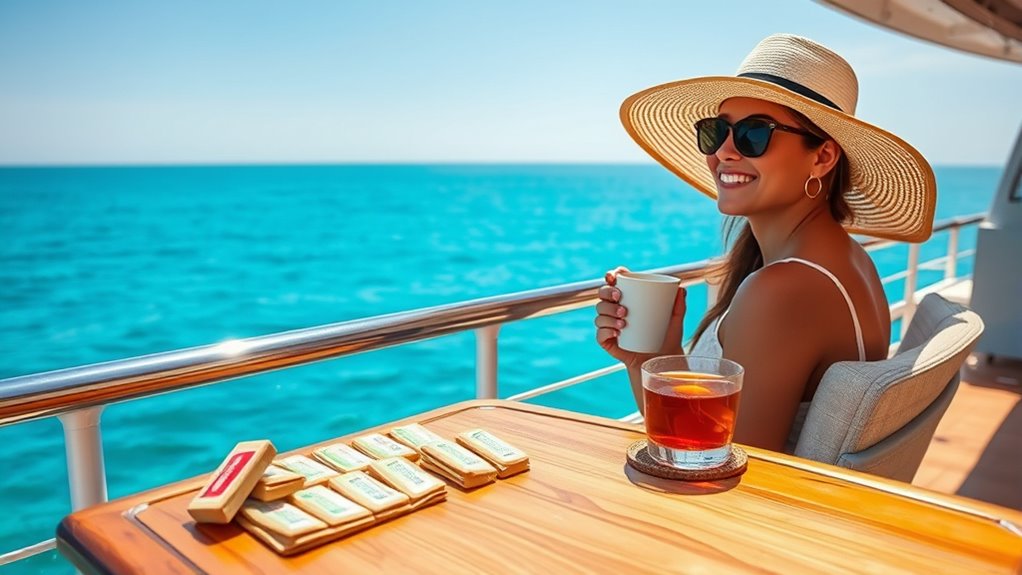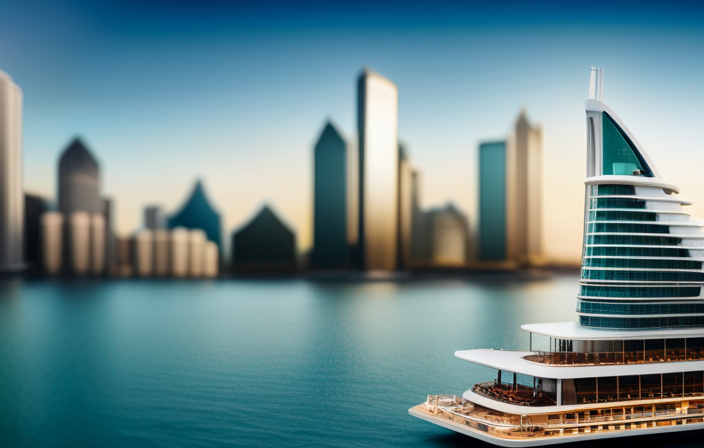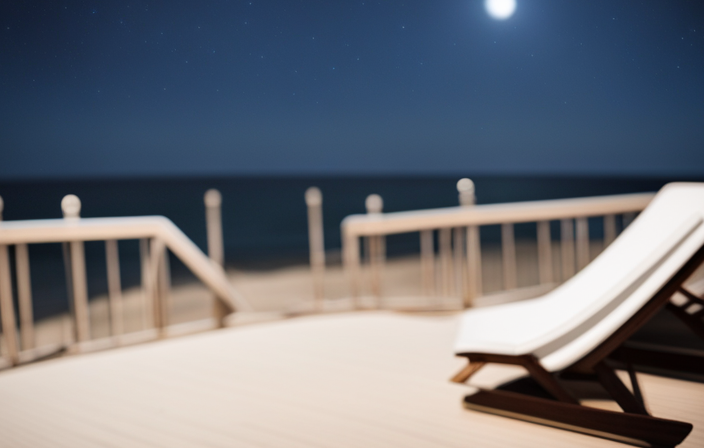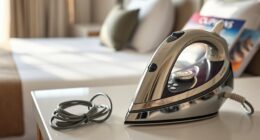To avoid seasickness on a cruise, choose a cabin mid-ship on a lower deck to feel less motion. Focus on the horizon and stay on deck, especially mid-ship, to help your brain interpret movement better. Pack remedies like motion sickness pills, ginger, or wristbands, and take them before the cruise starts. Stay hydrated, eat small meals, and keep calm—these tips can make your voyage more comfortable. Learn more ways to stay seasick-free ahead.
Key Takeaways
- Choose a mid-ship, lower deck cabin with windows or balconies for better stability and visual cues.
- Take over-the-counter or prescription remedies like Dramamine or scopolamine patches before sailing.
- Focus on the horizon and stay on the deck to help your brain interpret movement accurately.
- Eat small, frequent snacks and stay hydrated to prevent nausea and maintain comfort.
- Practice relaxation techniques and avoid strong odors to reduce anxiety and sensory overload.
Choose the Right Cabin Location
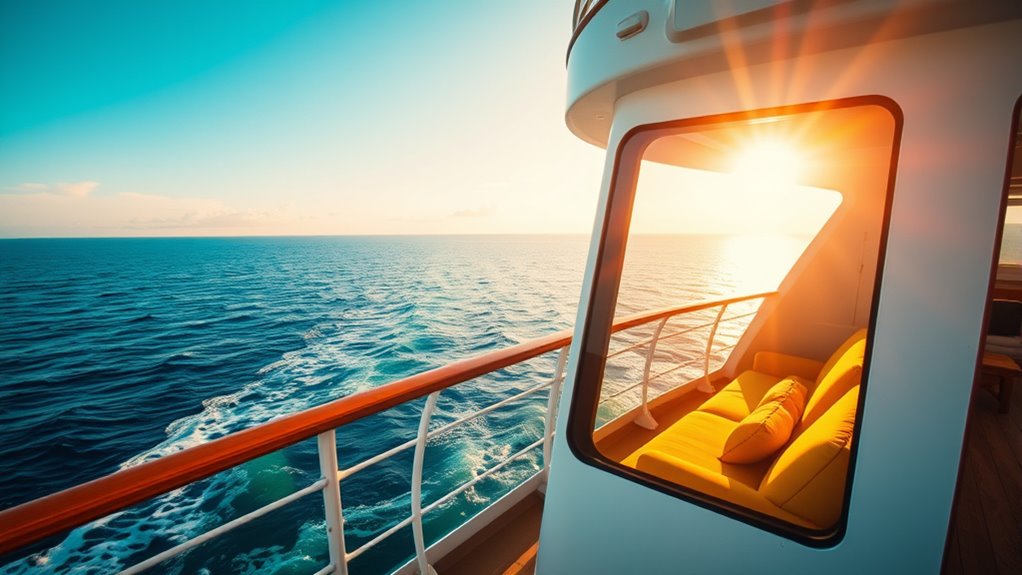
To reduce your chances of feeling seasick, it’s best to choose a cabin located mid-ship and on a lower deck. Mid-ship cabins experience less movement, helping to reduce seasickness symptoms. Opt for a lower deck, as these cabins sway less than those higher up, making your stay more comfortable. Avoid cabins at the front or back of the ship, where movement is more pronounced. Selecting a stateroom with a window or balcony provides visual cues, which help your brain interpret the ship’s motion and can lessen seasickness severity. The right location minimizes the sensation of movement, making your cruise more enjoyable. Additionally, understanding ship stability features can help you plan your trip to include relaxing activities and destinations, contributing to a smoother and more enjoyable cruise experience.
Select a Suitable Cruise Itinerary
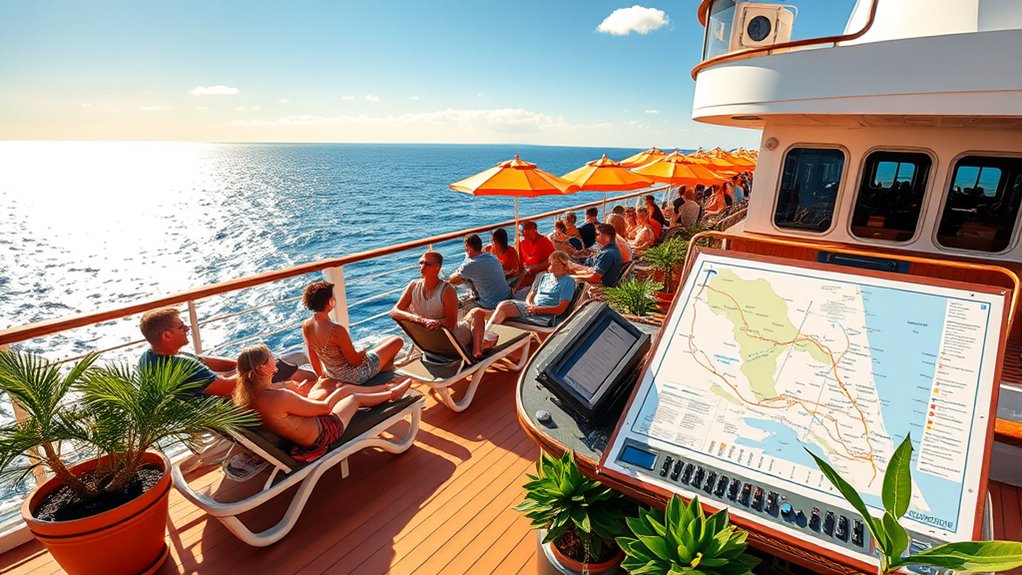
Choosing the right cruise itinerary can make a significant difference in avoiding seasickness. Opt for routes that feature shorter durations, typically 2-5 nights, to reduce time spent at sea. Select itineraries that travel through calm regions like the Caribbean or Mediterranean, especially outside hurricane season, for smoother sailing. Look for routes with multiple ports and shuttle stops, providing frequent breaks from open-ocean crossings. Avoid rough seas by researching sea conditions ahead of time and choosing routes that stay within sheltered or inland waters. Well-stabilized ships and gentle sailing tracks also contribute to a more comfortable experience. Additionally, some historic sites, such as those in Alaska, offer cultural significance, which can provide engaging activities that distract from seasickness. Incorporating ship design features focused on stability can further enhance your comfort during the voyage, especially as advancements in marine technology improve vessel steadiness. Being aware of rough sea conditions and planning accordingly can help you avoid discomfort and enjoy a more relaxed cruise. For added comfort, choosing ships equipped with stabilizers can significantly reduce rolling and pitching motions during rougher weather.
Pack Effective Remedies and Medications
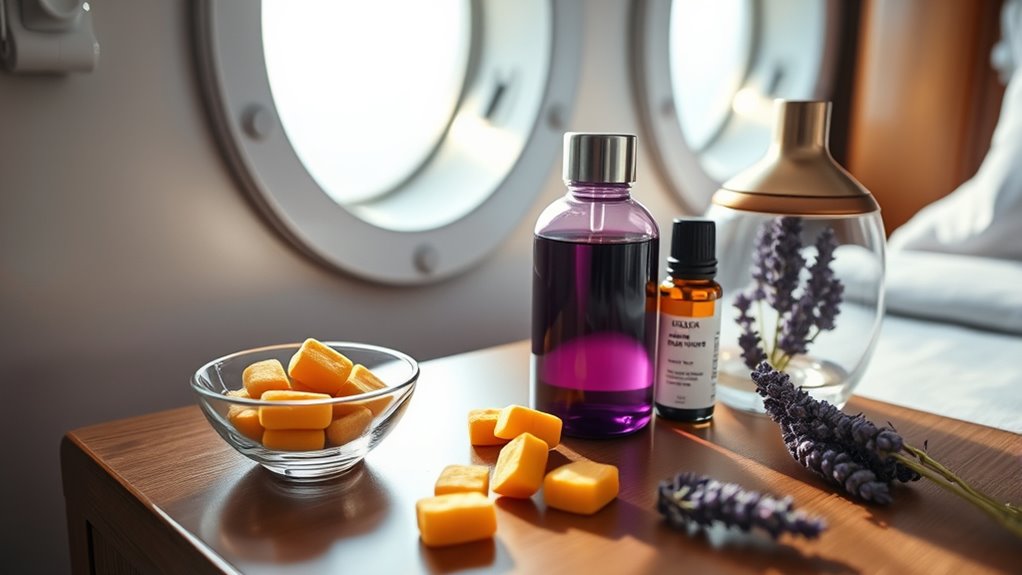
Bringing the right remedies and medications can substantially reduce your chances of experiencing seasickness. Pack over-the-counter medications like Dramamine or Bonine, taking them 30-60 minutes before departure for best results. Consider prescription remedies such as the scopolamine patch, which should be applied behind the ear at least 8 hours before sailing. Natural remedies like ginger supplements, candies, or tea may help reduce nausea without drowsiness. Acupressure wristbands, like Sea-Bands, apply gentle pressure on the Nei-Kuan point to prevent seasickness symptoms. It’s wise to bring a variety of seasickness remedies to experiment with, ensuring you find what works best for your susceptibility. Proper remedy experimentation helps you stay comfortable and enjoy your cruise without worry. Energetic alignment with your body’s needs can also play a role in preventing seasickness, promoting overall well-being during your voyage.
Practice Sensory Strategies During the Voyage

Practicing sensory strategies during your voyage can substantially reduce seasickness symptoms. Focus on visual cues like the horizon or distant objects to help your brain reconcile vestibular signals and improve sensory stability. Spend time on the ship’s deck, ideally mid-ship and lower decks, where motion feels less intense, aiding your sensory orientation. Use natural visual references such as windows or balconies to maintain balance. Regularly shift your focus between the horizon and nearby objects to prevent disorientation. Incorporate deep breathing and relaxation techniques to calm your sensory system. By aligning visual cues with your vestibular signals, you enhance sensory stability and reduce confusion. Understanding the importance of sensory integration can further improve your cruising experience. Here’s a quick guide:
| Sensory Technique | Purpose |
|---|---|
| Focus on the horizon | Reinforces visual cues, supports balance |
| Deck location (mid/lower) | Provides less motion, improves sensory orientation |
| Use natural visual cues | Maintains sensory stability |
| Shift focus regularly | Prevents disorientation |
| Deep breathing & relaxation | Calms the sensory system, reduces conflict signals |
Additionally, maintaining proper hydration and avoiding heavy meals before and during the voyage can support your sensory balance, as staying well-hydrated is essential for overall equilibrium and reduces motion sickness symptoms.
Maintain Proper Eating and Hydration Habits

To keep seasickness at bay, focus on eating small, frequent snacks like crackers or ginger ale to settle your stomach. Make sure to stay hydrated by drinking plenty of water and avoiding drinks like alcohol that can dehydrate you. Eating light, bland foods and recognizing early signs of nausea helps your body adapt and reduces discomfort during the cruise. Additionally, being mindful of foods to avoid such as grapes, which are harmful to dogs, can help prevent unnecessary digestive issues during your voyage. Incorporating hydration strategies such as electrolyte supplements or infused water can further support your well-being and help you enjoy your trip. Choosing healthy breakfast options like whole grains, fruits, and protein-rich foods can help maintain your energy levels and stabilize your mood while at sea. Incorporating sound design techniques such as gentle ambient sounds or calming melodies can also help you stay relaxed and positive throughout your trip.
Small, Frequent Meals
Eating small, frequent meals throughout the day helps keep your stomach stable and reduces the likelihood of nausea. Small meals prevent indigestion and overfullness, which can trigger seasickness. Incorporate light snacks like crackers, fruit, or ginger ale to maintain blood sugar levels and support nausea prevention. Frequent eating helps avoid heavy meals that can worsen motion sickness and discomfort. Focus on balanced cruise nutrition by choosing easily digestible foods that won’t upset your stomach. Recognizing early signs of nausea and eating small snacks promptly can prevent symptoms from escalating. Staying consistent with this eating pattern ensures your stomach remains calm, making it easier to enjoy your cruise while minimizing seasickness. Proper meal timing is a simple yet effective strategy for smoother sailing. Additionally, understanding seasickness and its causes can help you better prepare and implement effective prevention techniques, especially considering nausea triggers common onboard. Being aware of natural remedies like ginger or peppermint can also provide additional relief if symptoms arise.
Stay Hydrated Regularly
Staying well-hydrated is just as important as eating small, frequent meals when it comes to preventing seasickness. Proper hydration helps maintain your electrolyte balance, reducing dizziness and nausea. To stay hydrated, focus on your water intake and regularly sip fluids like still or sparkling water, such as San Pellegrino or Evian. Here are some tips:
- Drink fluids consistently throughout the day to prevent dehydration.
- Limit alcohol and caffeine, which can dehydrate you.
- Combine small snacks with fluid consumption to stabilize blood sugar and support hydration.
Prepare and Plan Ahead for a Comfortable Experience

To make your cruise more comfortable, start by choosing a calm route and a mid-ship, lower-deck cabin with a window or balcony. Pack effective remedies like motion sickness patches, antihistamines, and natural options such as ginger or acupressure bands. Planning ahead guarantees you’re prepared for smoother sailing and can enjoy your trip without unnecessary discomfort.
Choose the Right Cabin
Choosing the right cabin can make a significant difference in preventing seasickness on a cruise. To minimize motion, select a mid-ship cabin on the lower decks, as this location offers greater stability and less sway. Consider these tips:
- Choose a cabin with windows or balconies to provide visual cues, helping your brain interpret movement accurately.
- Avoid rooms at the front (bow) or back (aft), where movement is more intense.
- Opt for a centrally located cabin to improve balance and reduce disorientation caused by ship movement.
Pack Effective Remedies
Having the right cabin can greatly reduce seasickness, but packing effective remedies guarantees you’re prepared for any discomfort that might still arise. Bring over-the-counter remedies like Dramamine or Bonine, and consider prescription options such as scopolamine patches for prevention. Natural remedies like ginger capsules, tea, or candies can soothe nausea without drowsiness. Acupressure wristbands (Sea-Bands) apply gentle pressure on the Nei-Kuan point, helping reduce motion sickness symptoms. Prepare a small medical kit with antiemetics, seasickness patches, and personal remedies for quick access onboard. Research cruise itineraries, ships, and cabins in advance that are known for stability and calmer waters. Being proactive with these remedies ensures you stay comfortable and enjoy your voyage without seasickness interrupting your trip.
Frequently Asked Questions
What Is the Best Thing for Motion Sickness on a Cruise?
You’re wondering what’s best for motion sickness on a cruise. The most effective over-the-counter option is meclizine, which causes less drowsiness. For stronger prevention, a scopolamine patch applied behind your ear works well. Natural remedies like ginger or acupressure wristbands can also help. To stay comfortable, focus on the horizon and stay in the ship’s middle and lower decks. Combining these methods can keep you feeling great onboard.
Is It Possible to Not Get Seasick on a Cruise?
You can definitely avoid seasickness on a cruise if you take the right precautions. Choose a well-stabilized ship and cabin mid-ship on lower decks. Use preventative remedies like patches or acupressure bands, stay focused on the horizon, and get fresh air often. Opt for calmer routes, eat gently, and stay hydrated. With these steps, you’re much more likely to enjoy your cruise without discomfort.
What Is the Secret to Not Getting Seasick?
The secret to not getting seasick is like having a steady anchor in rough waters. You can achieve this by focusing on the horizon, which helps your brain align visual and balance signals. Choose a mid-ship, lower-deck cabin to minimize motion. Take preventative remedies like scopolamine patches or antihistamines, stay hydrated, avoid heavy foods, and try natural aids like ginger or acupressure wristbands. These steps keep your equilibrium steady and prevent seasickness.
What Are the Best Rooms on a Cruise Ship to Avoid Seasickness?
You should choose a room in the middle of the ship to minimize motion and reduce seasickness. Opt for a lower deck, as it experiences less sway. A cabin with a window or balcony offers visual cues to help your brain stay balanced. Avoid front and back cabins, where movement is stronger. If possible, select a room with stabilizers or on a ship known for advanced stabilization technology to make your journey smoother.
Conclusion
By choosing the right cabin, packing remedies, and staying hydrated, you can markedly reduce seasickness. Imagine Sarah, who followed these tips and enjoyed her cruise without discomfort, discovering new ports and making memories. Planning ahead and practicing sensory strategies can make all the difference. With a little preparation, you’ll turn a potentially uncomfortable trip into a smooth, enjoyable adventure—so don’t let seasickness hold you back from exploring the world on the open sea.
Claire, a creative soul with an unquenchable thirst for storytelling, is an integral part of the Voyager Info team. As a dedicated writer, she weaves captivating narratives that transport readers to enchanting cruise destinations and beyond.
Claire’s love affair with writing began at an early age when she discovered the magic of words and their ability to craft worlds and emotions. Her innate curiosity led her to explore various literary genres, but it was travel writing that truly captured her heart. Drawing inspiration from her own globetrotting adventures and encounters with diverse cultures, Claire embarked on a journey to become a travel writer par excellence.

